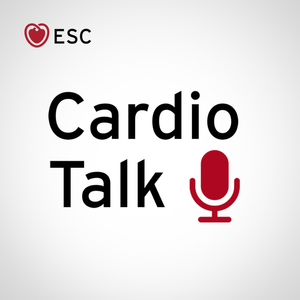
Circulation Jul 18, 2017 Issue
07/17/17 • 17 min
Dr. Carolyn Lam: Welcome to Circulation on the Run, your weekly podcast summary and backstage pass to the journal and its editors. I'm Dr. Carolyn Lam, Associate Editor, from the National Heart Center and Duke-National University of Singapore.
Now, the SGLT2 inhibitor, empagliflozin, has been shown to improve outcomes in the EMPA-REG OUTCOMES trial. But do these benefits also apply in the real world, and to other SGLT2 inhibitors as a class? Well, we may just have some answers this week in the CVD-REAL study. More soon right after these summaries.
The first original paper this week uncovers the mechanism of beneficial action of T-cells for proper healing after myocardial infarction. Now, the pro-inflammatory danger signal, adenosine triphosphate or ATP, is released from damaged cells, and degraded by the ectonucleotidase CD73 to the anti-inflammatory mediator, adenosine.
Using newly-generated CD4-CD73 null mice, first author, Dr. Borg, corresponding author, Dr. Schrader, and colleagues from Heinrich Heine University of Düsseldorf in Germany, showed that a lack of CD73 on T-cells enhanced tissue fibrosis and worsened myocardial function in the remodeling phase after myocardial infarction.
T-cells migrated into the injured heart and upregulated their enzymatic machinery to enhance the extracellular degradation of ATP to adenosine. T-cells lacking CD73 showed accelerated production of pro-inflammatory and profibrotic cytokines. Finally, the adenosine 2B receptor was upregulated on cardiac immune cells in the remodeling phase.
In summary, therefore, local adenosine formation by CD73 on T-cells appears to be the body's own defense mechanism to control inflammation induced by myocardial infarction. This is a mechanism that might be exploited to promote healing or remodeling by specifically targeting the adenosine 2B receptor in the infarcted heart.
The next paper provides insights on genetic determinants of susceptibility to peripheral artery disease, and specifically puts the spotlight on Bcl-2-associated athanogene-3, or Bag3, which is a cell chaperone protein previously identified in a genetic screen for determinants of tissue loss with hindlimb ischemia.
In the current study, Dr. McClung from East Carolina University, Brody School of Medicine in Greenville, North Carolina, and colleagues, used adeno-associated viruses to show that an isoleucine to methionine variant at position 81 in Bag3 was sufficient to confer susceptibility to ischemic tissue necrosis in BALB/c mice.
In a series of elegant experiments, they demonstrated that Bag3 was a modulator of ischemic muscle necrosis and blood flow. In summary, this study provides evidence that genetic variation in Bag3 plays an important role in the prevention of ischemic tissue necrosis, and highlights a pathway that preserves tissue survival and muscle function in the setting of ischemia.
The next study provides insights into inflammatory atherogenesis by studying psoriasis, a chronic inflammatory disease associated with an accelerated risk of myocardial infarction. First author, Dr. Lerman, corresponding author, Dr. Mehta from the NHLBI, National Institutes of Health in Bethesda, United States, and colleagues, hypothesized that the increased cardiovascular risk observed in psoriasis would be partially attributable to an elevated subclinical coronary artery disease burden composed of non-calcified plaques with high-risk features.
To test this hypothesis, they compared total coronary plaque burden, non-calcified coronary plaque burden, and high-risk plaque prevalence between 105 psoriasis patients, 100 older hypolipidemic patients eligible for statin therapy, and 25 non-psoriasis healthy volunteers. All patients underwent CT coronary angiography, and a sample of the first 50 psoriasis patients were scanned again at one year following therapy.
The authors found that patients with psoriasis had greater non-coronary burden and increased high-risk plaque prevalence compared to healthy volunteers. Furthermore, compared to older hypolipidemic patients, patients with psoriasis had elevated non-calcified burden, and equivalent high-risk plaque prevalence. Finally, improvement in skin disease severity was associated with an improvement in non-calcified coronary burden at one year.
The clinical implications are that patients with psoriasis have similar coronary artery disease risk as hyperlipidemic patients one decade older, and these patients with psoriasis should be screened earlier for cardiovascular disease and educated about their elevated risks. Further investigations focus on the longitudinal impact of psoriasis treatment on high-risk plaque morphology, as well as on the extent of cardiovascular risk mitigation in randomized trials.
Well, those were your summaries. Now for our feature discussion. Now, we've heard of the EMPA-REG OUTCOME trial, that prospect...
Dr. Carolyn Lam: Welcome to Circulation on the Run, your weekly podcast summary and backstage pass to the journal and its editors. I'm Dr. Carolyn Lam, Associate Editor, from the National Heart Center and Duke-National University of Singapore.
Now, the SGLT2 inhibitor, empagliflozin, has been shown to improve outcomes in the EMPA-REG OUTCOMES trial. But do these benefits also apply in the real world, and to other SGLT2 inhibitors as a class? Well, we may just have some answers this week in the CVD-REAL study. More soon right after these summaries.
The first original paper this week uncovers the mechanism of beneficial action of T-cells for proper healing after myocardial infarction. Now, the pro-inflammatory danger signal, adenosine triphosphate or ATP, is released from damaged cells, and degraded by the ectonucleotidase CD73 to the anti-inflammatory mediator, adenosine.
Using newly-generated CD4-CD73 null mice, first author, Dr. Borg, corresponding author, Dr. Schrader, and colleagues from Heinrich Heine University of Düsseldorf in Germany, showed that a lack of CD73 on T-cells enhanced tissue fibrosis and worsened myocardial function in the remodeling phase after myocardial infarction.
T-cells migrated into the injured heart and upregulated their enzymatic machinery to enhance the extracellular degradation of ATP to adenosine. T-cells lacking CD73 showed accelerated production of pro-inflammatory and profibrotic cytokines. Finally, the adenosine 2B receptor was upregulated on cardiac immune cells in the remodeling phase.
In summary, therefore, local adenosine formation by CD73 on T-cells appears to be the body's own defense mechanism to control inflammation induced by myocardial infarction. This is a mechanism that might be exploited to promote healing or remodeling by specifically targeting the adenosine 2B receptor in the infarcted heart.
The next paper provides insights on genetic determinants of susceptibility to peripheral artery disease, and specifically puts the spotlight on Bcl-2-associated athanogene-3, or Bag3, which is a cell chaperone protein previously identified in a genetic screen for determinants of tissue loss with hindlimb ischemia.
In the current study, Dr. McClung from East Carolina University, Brody School of Medicine in Greenville, North Carolina, and colleagues, used adeno-associated viruses to show that an isoleucine to methionine variant at position 81 in Bag3 was sufficient to confer susceptibility to ischemic tissue necrosis in BALB/c mice.
In a series of elegant experiments, they demonstrated that Bag3 was a modulator of ischemic muscle necrosis and blood flow. In summary, this study provides evidence that genetic variation in Bag3 plays an important role in the prevention of ischemic tissue necrosis, and highlights a pathway that preserves tissue survival and muscle function in the setting of ischemia.
The next study provides insights into inflammatory atherogenesis by studying psoriasis, a chronic inflammatory disease associated with an accelerated risk of myocardial infarction. First author, Dr. Lerman, corresponding author, Dr. Mehta from the NHLBI, National Institutes of Health in Bethesda, United States, and colleagues, hypothesized that the increased cardiovascular risk observed in psoriasis would be partially attributable to an elevated subclinical coronary artery disease burden composed of non-calcified plaques with high-risk features.
To test this hypothesis, they compared total coronary plaque burden, non-calcified coronary plaque burden, and high-risk plaque prevalence between 105 psoriasis patients, 100 older hypolipidemic patients eligible for statin therapy, and 25 non-psoriasis healthy volunteers. All patients underwent CT coronary angiography, and a sample of the first 50 psoriasis patients were scanned again at one year following therapy.
The authors found that patients with psoriasis had greater non-coronary burden and increased high-risk plaque prevalence compared to healthy volunteers. Furthermore, compared to older hypolipidemic patients, patients with psoriasis had elevated non-calcified burden, and equivalent high-risk plaque prevalence. Finally, improvement in skin disease severity was associated with an improvement in non-calcified coronary burden at one year.
The clinical implications are that patients with psoriasis have similar coronary artery disease risk as hyperlipidemic patients one decade older, and these patients with psoriasis should be screened earlier for cardiovascular disease and educated about their elevated risks. Further investigations focus on the longitudinal impact of psoriasis treatment on high-risk plaque morphology, as well as on the extent of cardiovascular risk mitigation in randomized trials.
Well, those were your summaries. Now for our feature discussion. Now, we've heard of the EMPA-REG OUTCOME trial, that prospect...
Previous Episode

Circulation July 11, 2017 Issue
Dr. Carolyn Lam: Welcome to Circulation on the Run, your weekly podcast summary and backstage pass to the journal and its editors. I'm Dr. Carolyn Lam, associate editor from the National Heart Center and Youth National University of Singapore. Coming right up, we will be discussing fascinating new data on the prevalence of subclinical coronary artery disease in masters endurance athletes but first, here's your summary of this week's journal. The first paper provides insight into ischemic cellular post conditioning. Now, we know that cardiosphere derived cell therapy has been utilized as a strategy to treat ischemic heart disease and reduce chronic scar burden when administered months after myocardial infarction. In the current study, by first author Dr. de Couto, corresponding authors Dr. Marban and Berman from Cedars-Sinai Heart Institute in Los Angeles, California, the authors used rat and pig models of myocardial infarction to show that exosomes, which are nanosize lipid bi-layer vesicles, actually mediate the cardio protective effects of cardiosphere derived cells when administered after reperfusion of myocardial infarction.
They further show that treatment with either cardiosphere-derived cells or their secreted exosomes reduce infarct size and improved functional recovery. Using RNA sequencing to determine exosome content and alterations in gene expression profiles on macrophages from cardiac tissue or bone marrow, they found that a specific micro RNA species miR 181-B within the exosomes, acted on macrophages and was implicated as a key mediator of the cardio-protective benefits. Thus, this study gives new reason to test the idea that allogeneic cardiosphere-derived cells may be efficacious in preventing scar formation and improving cardiac function, when given in the earlier reperfusion period. The data further support that exosomal transfer of miR 181-B from these cardiospheric-derived cells into macrophages underlie the cardio-protective effects after reperfusion.
The next study describes a potential new therapeutic strategy for vasoproliferative retinopathy which can underlie age-related macular degeneration, the leading cause of blindness in industrialized nations. First author, Dr. Bucher, corresponding authors Dr. Yea and Friedlander, from the Scripps Research Institute in La Jolla, California used rodent models of retinal neo-vascular disease to show that Tspan-12, beta-catenin signaling plays an important role in the development of vasoproliferative retinopathy. As background, Tspan-12 belongs to the Tetraspanin family, which mainly includes cell surface proteins characterized by four transmembrane domains and two extra cellular domains.
Members of the Tspan family participate in a diverse cellular processes and act as signaling platforms by forming Tspan-enriched micro domains in plasma membranes. The authors went further to use a novel phage display combinatorial antibody library to specifically design a Tspan-12 blocking antibody which is capable of interacting with human and mouse Tspan-12 antigen. They then provided strong evidence that the Tspan-12 blocking antibody prevents developmental pathological neovascularization in murine models of vasoproliferative retinopathy. Combination therapy with a known anti-VEGF agent demonstrated significant synergy supporting the potential clinical use of the anti-Tspan-12 antibody as a novel angiomodulatory agent.
The next study addresses the paradox that blacks have higher coronary heart disease mortality compared with whites, but non-fatal coronary heart disease risks may be lower for black versus white men. To address this paradox, first author Dr. Colantonio, corresponding author, Dr. Safford and colleagues from Weill Cornell Medical College in New York, compared fatal and non-fatal coronary heart disease incidents and case fatality among blacks and whites in three studies. The Atherosclerosis Risk in Communities or ARIC study, cardiovascular health study, and reasons for geographic and racial differences in stroke or regards study, all stratified by gender.
They found that the incidents of non-fatal coronary heart disease was consistently lower among black versus white men, although black men have a higher burden of unfavorable social determinants of health and cardiovascular risk factors and a higher fatal coronary heart disease incidents. Following adjustment for social determinants of health and cardiovascular risk factors, black men and women had a similar risk of fatal coronary heart disease, but a lower risk of non-fatal coronary heart disease compared with white men and women respectively. Finally, blacks with incident coronary heart disease had a higher case fatality compared with whites and the difference remained similar after adjustment for social determinants of health and risk factors. Thus, there is an apparent lower risk for non-fatal coronary heart disease among black versus white ...
Next Episode

Circulation July 25, 2017 Issue
Dr. Carolyn Lam: Welcome to Circulation On The Run, your weekly podcast summary and backstage pass to the journal and its editors. I'm Dr. Carolyn Lam, associate editor from the National Heart Center and Duke National University of Singapore. Our journal this week features an in-depth review on transcatheter therapy for mitral regurgitation, a very, very hot and interesting topic. You have to listen on, coming up right after these summaries.
Our first original paper this week sheds light on the influence of aging on aldosterone secretion and physiology. First author Dr. Nanba, corresponding author Dr. Rainey and colleagues from the University of Michigan in United States, examine the relationship between age and adrenal aldosterone synthase in 127 normal adrenals from deceased kidney donors. The donors' ages ranged from nine months to 68 years. The authors found that adrenals from older individuals displayed less normal aldosterone synthase expression and zona glomerulosa, and greater content of abnormal foci of aldosterone synthase expressing cells.
Furthermore, older age was independently associated with dysregulated and autonomous aldosterone physiology, in an ancillary clinical study of subjects without primary aldosteronism. This study therefore suggests that aging may be associated with a sub-clinical form of aldosterone excess and provides at least one potential explanation for age related cardiovascular risk.
The next study shows, for the first time, that the chemokine receptor, CXCR4, in vascular cells, limits atherosclerosis. The CXCL12 and CXCR4 chemokine ligand receptor axis is known to control cell homeostasis and trafficking. However, its specific in atheroprotection has thus far been unclear. This is addressed in today's study by first author Dr. During, corresponding author Dr. Weber, and colleagues of The Institute for Cardiovascular Prevention in Munich, Germany. In hyperlipidemic mice, the authors showed that cell-specific deletion of CXCR4 in arterial endothelial cells, or smooth muscle cells, marked the increase atherosclerotic lesion formation. Mechanistically, CXCR4 axis promoted endothelial barrier function through VE-cadherin expression and a stabilization of junctional VE-cadherin complexes. In arterial smooth muscle cells, CXCR4 sustained vascular reactivity responses, and a contractile smooth muscle cell phenotype. Whereas, CXCR4 deficiency favored the occurrence of macrophage-like smooth muscle cells in atherosclerotic plaques and impaired cholesterol efflux.
Finally, in humans, the authors identified a common allele variant within the CXCR4 locus that was associated with reduced CXCR4 expression in carotid RG plaques, and increased risk for coronary heart disease. Thus, the study suggests that enhancing the atheroprotective effect of arterial CXCR4 by selective modulators may open normal therapeutic options in atherosclerosis.
The next paper is the first to study the effects of rosuvastatin on carotid intima-media thickness in children, with heterozygous familial hypercholesterolemia. First author Dr. Braamskamp, corresponding author Dr. Hutten, and colleagues from Academic Medical Center Amsterdam in the Netherlands, study children with heterozygous familial hypercholesterolemia aged 6 to less than 18 years, with LDL cholesterol more than 4.9, or more than 4.1 millimoles per liter in combination with other risk factors, who received rosuvastatin for 2 years, starting at 5 milligrams once daily, with uptitration to 10 milligrams for children aged 6 to 10 years old, or 20 milligrams daily for those aged 10 to 18 years old.
Carotid intima-media thickness was assessed by ultrasonography at baseline, 12 months and 24 months in all patients and in age-matched, unaffected siblings. Carotid intima-media thickness was measured at 3 locations, the common carotid artery, the carotid ball, and the internal carotid artery in both the left and right carotid arteries. At baseline, the mean carotid intima-media thickness was significantly greater for the 197 children with heterozygous familial hypercholesterolemia compared with the 65 unaffected siblings. Rosuvastatin treatment for 2 years resulted in significantly less progression of increased carotid intima-media thickness in children with heterozygous familial hypercholesterolemia than in the untreated, or unaffected siblings. As a result, there was no difference in carotid intima-media thickness between the two groups after two years of rosuvastatin. These findings, therefore, support the value of early initiation of statin treatment for LDL cholesterol reduction in children with heterozygous familial hypercholesterolemia.
The final study highlights the therapeutic potential of a novel alpha calcitonin gene-related peptide for the treatment of heart failure. First author Dr. Aubdool, corresponding author Dr. Brain, and colleagues from King's College London in United Kingdom, ...
If you like this episode you’ll love
Episode Comments
Generate a badge
Get a badge for your website that links back to this episode
<a href="https://goodpods.com/podcasts/circulation-on-the-run-255644/circulation-jul-18-2017-issue-29730654"> <img src="https://storage.googleapis.com/goodpods-images-bucket/badges/generic-badge-1.svg" alt="listen to circulation jul 18, 2017 issue on goodpods" style="width: 225px" /> </a>
Copy




